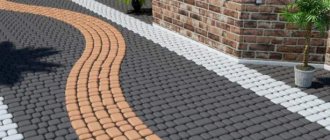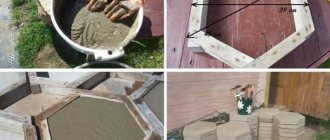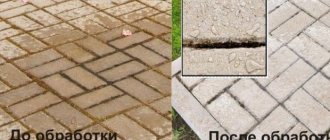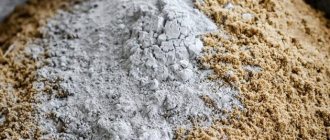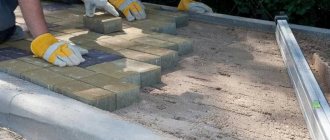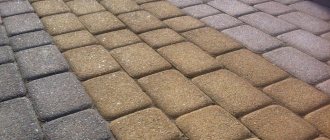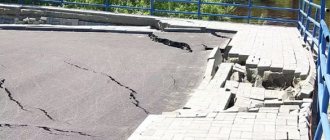Traditional asphalt or concrete road surfaces are now being successfully replaced by paving slabs. The alternative, varied in shape and color, changes the appearance of familiar courtyards, playgrounds, driveways, squares and parks beyond recognition. Paving slabs have many advantages, both purely technical and aesthetic; they will fit perfectly into any landscape design project where at least one path will be designed, and will add a unique flavor and completeness to the landscaped area.
Types and characteristics of paving slabs
Concrete slabs for paving sidewalks are produced in two ways, which have their positive aspects:
- Vibrocasting is a simple and well-proven technology. The tiles created by this method are quite wear-resistant and uniform in structure, durable, and if the production rules are followed, they have a magnificent appearance. The only drawback is that it cannot withstand heavy mechanical loads.
- Pressing is an innovative technological method, more expensive than the previous one, but the created tiles are more durable and can be used on road sections with increased weight loads.
The main components are high-quality cement, sand and a little water, sometimes fine gravel is added to the solution as a filler and to create a specific structure. To add color, special dyes are used, which are added directly to the solution when mixing, or paints for surface application to paving slabs. It is worth noting that excessively bright shades may be a sign of poor proportions, which will lead to a deterioration in the quality of the material.
To increase strength and abrasion resistance, fiber or other reinforcing elements are added to the solution.
How much does a package of tiles weigh?
It is important to calculate the weight of a package, pack or whole pallet when purchasing this material. The cost of delivery or the ability to transport the tiles yourself, unload them or lift them to the floor depends on this.
All tiles are sold in cardboard packages. Typically, the larger the tile size, the fewer pieces in the package. Tiles 20X20 cm are most often supplied in 20-25 pieces, and tiles measuring 30X30 cm are sold in 10 pieces.
Knowing the weight of one tile and the number of them in a package, you can easily calculate the weight of one package. This means assessing the convenience or cost of transportation and unloading. For example, a pack of 25 x 20 x 10 cm ceramic tiles will weigh 18.5 kg.
Based on these tables and taking into account the characteristics of a particular material, you can easily make any calculations.
Advantages
The indisputable advantages of laying paving slabs on roads, paths and sidewalks are:
- ease of installation,
- large selection of textures and colors,
- durability and abrasion resistance,
- environmental cleanliness,
- chemical inertness,
- frost resistance, heat resistance, moisture resistance,
- puddles do not form on the surface of properly laid paving slabs,
- The water balance of the soil is not disturbed, which is important for garden plots.
How exactly is a vibropressed slab produced?
Unlike the technologies of cast and vibro-cast tile production, during vibro-compression concrete is compacted not only by vibration, but also by compression. Installations for the production of vibropressed tiles provide vertical pressure on the form with concrete (compression, pressing) and at the same time subject the form to vibration. Due to this, the density of the finished tile is higher than the density of cast or vibrocast tiles.
Composition of concrete for vibropressed paving slabs from the manufacturer:
- cement grade M-500;
- sand;
- crushed stone;
- plasticizers;
- hydrophobic additives;
- water.
The difference from vibrocast tiles is the amount of water. For vibrocompression, “dry” mixtures with a minimum amount of water are used. The mobility of such concrete is low, so vibration without additional pressing will not force the mixture to completely fill the mold.
The composition of concrete for tiles is not regulated by GOST, so large tile manufacturers use various additives and change the percentage of ingredients to increase the strength, wear resistance and frost resistance of the tiles.
Weight of paving slabs
When preparing a project for laying a garden path, sidewalk or area near a house, you need to accurately calculate the surface area in order to buy the right amount of tiles. But it often happens that a small amount of material is still not enough, because tiles are bought in whole pallets or square meters. The weight of a pallet of paving slabs is quite large, since it contains an average of 12.5 square meters. Depending on the thickness of the product, the weight of a pallet of paving slabs can range from 660 kg (with a tile thickness of 3 cm) to 1600 kg (with a thickness of 6 cm).
It is much easier to calculate the weight of a purchase by square meters. paving slab weighs ). Multiplying the result by the mounting surface area, we obtain the weight of the entire purchased batch.
So, for example, the weight of paving slabs 400x400x50 per square meter is 140 kg, one piece weighs 30 kg. Square shapes are considered the most popular, since they are easier to install than curly ones, and the design of the front side allows you to create a wide variety of patterns on the surface. It is convenient to cover large areas of pedestrian garden paths, embankments or squares near fountains with large tiles. Weight of paving slabs 500x500x50 1 piece - 33 kg.
It is not difficult to work with and the process moves quite quickly. Weight table of the most popular types of paving slabs
| Model | Dimensions | Weight of 1 piece (kg) | How many pieces in 1 m2 | Weight 1 m2 (kg) |
| square | 200x200x60 | 4,6 | 25 | 92 |
| paving stones (brick) | 200x100x60 | 2,3 | 50 | 115 |
| 8 bricks | 500x500x50 | 33 | 4 | 132 |
| rhombus | 200x200x60 | 4,6 | 25 | 92 |
| zigzag | 222x110x60 | 3,2 | 40 | 128 |
What determines the weight of paving stones?
The weight of paving stones is influenced by several factors:
- Material of manufacture . Depending on it, products can be one of three types - clinker, stone or concrete. Concrete - made of concrete with various admixtures. Clinker - obtained by firing special clays. Stone - created from different types of stone, they are the heaviest, but also the most durable.
- Product standard size . It is determined by the length, width and thickness of the products. The weight of a brick paving stone will be greater than the weight of a tile with the same length and width.
- Production technology . Paving stones made by vibrocompression will be significantly heavier than those obtained as a result of vibrocasting.
- Raw materials used . The composition of consumables is regulated by GOST, but some manufacturers manufacture products according to specifications. For example, to increase the strength characteristics of products, granite chips can be added to the raw material. And this leads to weight gain.
Most paving stones are made using vibratory pressing, while stone paving stones can be split or sawn and are made from sandstone, marble, granite and basalt
Honeycomb Tile
Tile Wave
Gossamer Tile
Brick
California tile
Stone paving stones are the heaviest
Recommendations before purchasing
When choosing paving slabs you need to pay attention to:
- A good product cannot be cheap. Low price means deterioration in technical characteristics.
- Product batches may vary significantly in shades. It is necessary to provide a reserve of 5-7% of the planned quantity. It is also recommended to save the remains so that in case of repair you do not have to buy a new batch, which may have a different shade. When laying diagonally, the margin must be increased due to the high costs of cutting.
- The standard allows up to 5% defects in a batch of any product, even the highest quality;
- Glossy products must be checked for excessive moisture content and degree of strength before purchase. This is done by hitting two tiles against each other. A ringing sound indicates good quality of the product, and a dull sound indicates that there is too much water in the material. Such a defect can be suspected by the high gloss of the product;
- If the color coating is too bright, this may indicate the addition of cheap pigment, which is a violation of the manufacturing technology and negatively affects the strength of the product. But it is high quality materials that have rich colors. In this case, the pigment should be uniform and not blurred, and the reverse side should not have yellowish spots. Such tiles are guaranteed to be damaged within a couple of years, since they were made with a clear violation of technology.
Description and scope of application
Paving slabs “8 bricks” are very popular among consumers. It, as the name suggests, imitates the appearance of brick. This is significantly cheaper than using natural brick. The expressive structure increases the attractiveness of the finish.
This option is supported by:
rigor of style (suitability for any place); a perfectly flat surface (no debris will get stuck in it); graceful square shape; increased resistance to mechanical stress; excellent load-bearing characteristics; resistance to meteorological influences; ideally even design and arrangement of all parts, which is very important for paths in country houses and gardens; sufficient reliability even in car parks.
Dimensions and weight
If you need to choose the thinnest paving slabs, then you should consider blocks measuring 400x400x40 mm. This solution is optimal for home use. With a mass of 80 kg per 1 sq. m it will be possible to lay out 96 400x400 blocks on a standard pallet. You can also take another tile measuring 40x40 cm, or more precisely, 400x400x50 mm. In this case, the density will be 100 kg per 1 m3. In this case, however, 96 pieces can be placed on a pallet in exactly the same way.
Sometimes they try to order more durable material. Then they prefer tiles 400x400x70 mm. Its specific gravity already reaches 150 kg per 1 cubic meter. m. 72 tiles are placed on each standard pallet. If you buy products 300x300x30, then the weight of one block is 10.5 kg. 11 pieces are placed on a typical pallet, which is an area of 10 m2.
On pallets with a capacity of 240 pieces, enough 300x300 mm tiles are laid out to cover 21.8 square meters. m. The rather large mass is due to the fact that concrete of a strength class no worse than B22.5 is used. It is prepared on the basis of M500 cement, which initially does not contain any additives.
There are also vibropressed tiles 500x500x50 mm on the market. For 1 sq. m there are 4 such products. The weight of one copy reaches 25 kg. The mass of a pallet with 48 pieces is 1600 kg. As for ordinary paving slabs (vibro-cast), the density per 1 sq. m is 100 kg, and water absorption is a maximum of 5%.
What to consider when choosing and installing?
The vibro-cast type of tile is obtained relatively simply and cheaply. However, it is not always of high enough quality. It is difficult to maintain exact dimensions. A more advanced (but also more expensive, alas) solution is vibrocompressed material. It has excellent durability and low wear.
Thickness is critical:
- up to 4 cm - only for pedestrian paths;
- up to 6 cm - for places with a large flow of passers-by, for bicycle paths;
- 8 cm is an excellent option for driveways, garage entrances and street parking spaces.
The installation itself necessarily involves precise marking. Moreover, you should not assume that the quality and precision of the geometry of the tiles allows you to refuse its exact fit. Geotextiles are ideal as a primary base (soil separator and weed blocker). Crushed stone of a fraction no larger than 4 cm, river (or washed quarry) sand, curbs made of stone or plastic, and cement no worse than M400 will also be useful for the work.
Recommendations:
- lay out paths along which two oncoming people can calmly pass;
- if you have to prepare an entrance or passage for a car (motorcycle), you must also provide the opportunity for a person to stand without leaving the sidewalk;
- immediately when marking, leave a margin of 0.1 m on each side for future curbs;
- remove 0.3-0.35 m of fertile layer, unless adding dense soil is planned;
- tuck geotextiles at the edges by at least 0.2 m;
- compact the filled crushed stone with a vibrating plate;
- avoid laying tiles on old concrete;
- from the very first rows - monitor the accuracy of the layout by level;
- eliminate all defects and deviations immediately, without relying on the fact that something will correct itself;
- cut off the necessary fragments of tiles only with a powerful, reliable tool;
- carefully think through the design in advance, and if in doubt, consult with designers.

